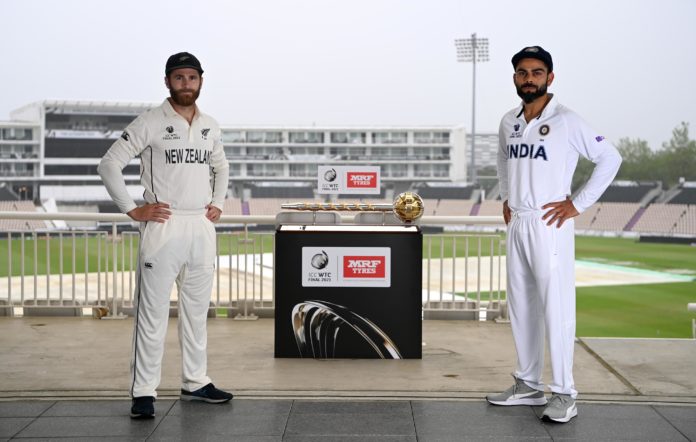Southampton: The recently concluded ICC World Test Championship in England may have shown a new door for the future of game. In fact, it was actually created with an intention for having a premier championship tournament for the longest format of the game because the other two formats ODI and T20 which have already have their pinnacle tournaments in the form of World Cup have already went a step forward.
However, test cricket being founder format of the game and with a history of age old legacy needed one big step up and that too considering the growing popularity of T20 cricket and the ODI. That’s when International Cricket Council (ICC) planned to make it happen. A championship with all the top nine test playing nations battle it of two years before making it to the final. In the end, New Zealand defeated India by 8 wickets lifting the trophy in the inaugural edition of the tournament at the Rose Bowl, Southampton in England.
The Journey so far hasn’t been easy. Initially the plan of action was twice cancelled, first in 2013 and then again in 2017 but when it finally took-off in 2019 it surprisingly created buzz among the fans all around the world.
So let us see how the things have panned-out with a few takeaways from inaugural World Test Championship.
Increasing Popularity of Cricket in White strips:
Amidst the glitz, and glamour of T20 cricket, the contrasting soothing nature of Test matches seemed to lose its charm. However, due the abundance of limited over games and various commercial leagues. It tended to become a bit monotonous and that’s where probably the WTC played the perfect role especially when the curtain raiser of the 2019-21 season was the Ashes started on 1 August 2019, a series which had drama and emotion from the first game to the last before it fittingly ended though before the a rain-hit final action-packed encounter between India and New Zealand with the Kiwis lifting the trophy in the inaugural edition of the tournament at the Rose Bowl, Southampton. Furthermore that old-school never ending suspense of what’s and ifs in every session of a five-day game delivering excitement to the spectators. Also the battle between the willow and the leather on a equal standpoint also played it part for people to enjoy.
Art of Fast bowling in Test cricket at its best:
View this post on Instagram
The art of swinging and seaming the red leather were becoming an off-topic with fast bowling failing to replicate its ethics in limited overs cricket especially T20. Bigger bats and shorter boundaries seemed also to go in favor of batsman these days. However, the WTC gave that perfect platform showing what excitement can the classic fast-bowling can bring.
In fact heading into the final, India and New Zealand had two of the best pace attacks in the world and they lived up to the expectations with the conditions setting the stage up perfectly. Kiwi seamer Kyle Jamieson had an outing tor remember while India’s Mohammed Shami, whose place in the XI itself wasn’t even guaranteed ripped through New Zealand’s heart on day five to bring India back into the contest. However, Tim Southee, Jamieson and Wagner produced bursts that arguably won New Zealand the Test on day six testing the Indian batting line up to limit showing again that fast bowling is still there to be seen.
Batsmen with white ball genes can still succeed in red ball game:
Many people argued the negative impact of limited overs cricket on the technical abilities of a batsman. Considering the sheer temperament, a batter needs to have to survive against a formidable bowling line up in a five-day game. On the other hand, the test specialists batsman few years back were way too much concerted on playing through the sessions and not through the overs which created a boredom environment. However, the next generation of batters showed that they can adapt to any situation and can implement the free flowing stroke play near to perfect in the red ball game irrespective of the conditions. The likes of Rishav Pant, Subhman Gill, Quinton de Kock and Marnus Labuschagne seemed to have mastered this art of making the perfect balance of offence and defence.
Bowlers who can bat can be decisive:
After the WTC final, it looked like gone are the days where tail-enders were only there to do their primary job swinging their arms in bowling or to some extent act as a night-watchman. At 162-6, New Zealand seemed to have lost their grip on the game, but Jamieson and Southee batted their way adding valuable runs to help them take a lead. The last four wickets accumulated 58 runs compare to India’s tail which barely held up in both innings. In fact, in India’s final test match against Australia at the Gabba earlier this year, because of the tail’s performance, that India were able find their feat before winning the game and seal the series.
Apart from all of this, these two years have given so many splendid performers who became the talisman for their side’s journey. In fact its those few consistent star performers for which the teams sealed victories . Here are the top five who were to watch out for:
Marnus Labuschagne: Considered as the future of batting for Australia, Labuschagne had superb World Test Championship piling up runs for his nation in almost every condition with phenomenal consistency becoming an integral part of the batting line up, Despite his age he topped the scoring charts with 1675 runs from 13 tests at a stunning average of 72.82 hitting five centuries as well as nine fifties in the tournament with the highest score of 215.
Ravichandran Ashwin: For India, Ravichandran Ashwin has been the man of the campaign. The veteran off-spinner proved to be a match winner for the men in blue guiding them to the final. He was top wicket-taker in the tournament with 71 wickets in 14 Tests at an average of 20.33. He picked up four fifers in the tournament with the best figures of 7/145 while being as handy with the willow hitting a century against England.
Pat Cummins: While Marnus Lasuchagne topped for Aussie batting line up, Pat Cummins did it with the led leather. The burly seamer from Westhead was the the highest wicket-taker for Australia in the tournament while finishing as the second overall with 70 wickets in 14 Tests at an average of 21.02. The number one ranked bowler in ICC test rankings, Cummins picked up just one five-wicket haul in the tournament but always a consistent threat to the opposing batting line up with his pace, tenacity nd lengths making batsman smell the leather.
Ben Stokes: In Ben Stokes, England found a match winner who could aid with both bat and ball. Its very rare to find and all-rounder to perform in the longest format of the game however, the man who played his his part for making England World Champion two years back seemed to do it with ease. He has been one of the best all-rounders going around in the world. The burly Englishman finished as the fourth-highest run-getter in the tournament with 1334 runs in 17 Tests at an average of 46 hitting four centuries and six half-centuries in the tournament alongside being the striker of most number of sixes in the tournament.
However, it his 135 not out against Australia in the Ashes for which he will be most remembered. That unbeaten knock will go down as one of the best knocks in the history of the game as he salvaged his side.
Kyle Jamieson: New Zealand have found a gem in the form Kyle Jamieson. The Lanky Kiwi seamer spearhead the bowling his nation’s attack in the final of the ICC World Test Championship picking up seven wickets in the game running havoc at the Indian batting line up and won the man of the match award. He finished the tournament with 43 wickets in 7 Tests at an average of 12.53. A handy batsman down the order, his knack playing crucial hands benefited New Zealand in few games.





















